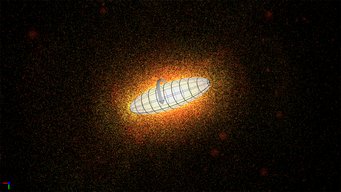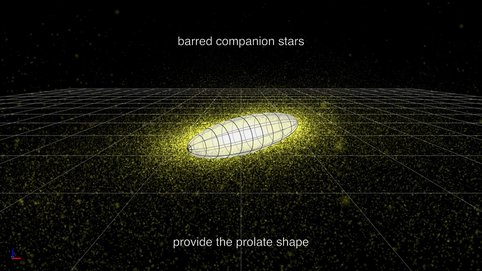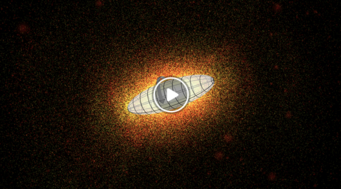Astronomers discover unusual spindle-like galaxies
| Background information | Download area | In-depth description of the results |
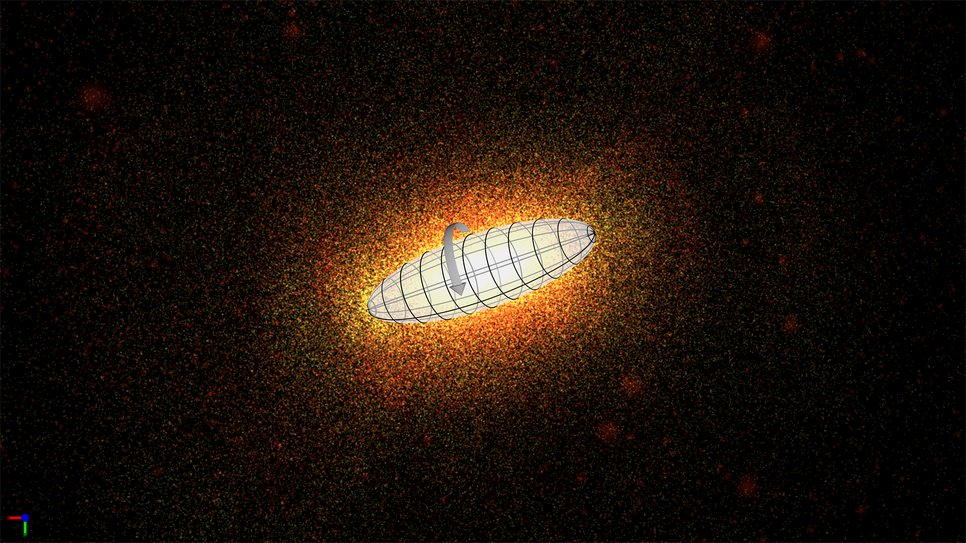
When most people think of galaxies, they think of majestic spiral galaxies like that of our home galaxy, the Milky Way: billions of stars, rotating in a flat disk similar to the way that a wheel rotates around its central axis. But there is another kind of galaxy, which used to be thought very rare: so-called prolate rotators, each shaped like a cigar, which rotates along its long axis, like a spindle.
Now, a group of astronomers led by Athanasia Tsatsi of the Max Planck Institute for Astronomy has completed a thorough study of these cosmic spindles. Using data from the CALIFA survey, a systematic study that examined the velocity structure of more than 600 galaxies, the astronomers discovered eight new prolate rotating galaxies, almost doubling the total known number of such galaxies (from 12 to 20). Cosmic spindles are considerably less rare than astronomers had thought!
Given the high quality of their data, the astronomers were able to propose a plausible explanation for how these cosmic spindles come into existence. In general, galaxies grow when they merge with other galaxies. Several mergers with smaller galaxies have made our own Milky Way the stately disk it is today. To make a cosmic spindle, two large disk galaxies need to collide at right angles, as shown in this animation:
As the galaxies begin to interact via gravitational attraction, one of them forms a bar: an elongated structure near the center. That bar becomes the cigar-like shape of the merged galaxy, while the orbiting stars of the other galaxy imbue the merged galaxy with its overall sense of rotation.
The results are an interesting piece of the puzzle, explaining a likely formation scenario for an unusual, but not all that uncommon type of galaxy. Tsatsi's team of researchers having put to good use all the information contained in the CALIFA data, the ball is now in the court of the observing astronomers again: the merger simulations make some additional predictions for the detailed properties of prolate rotators. These cannot be distinguished with the current observations, but could be tested with instruments like MUSE, the Multi Unit Spectral Explorer at ESO's Very Large Telescope, an 8-meter-telescope at Paranal Observatory in Chile.
Background information
The results here will be published in the journal Astronomy & Astrophysics as Tsatsi et al., "CALIFA reveals prolate rotation in massive early-type galaxies: A polar galaxy merger origin?"
- Link to Online Version of the article: https://doi.org/10.1051/0004-6361/201630218
The team members are Athanasia Tsatsi, Glenn van de Ven, and Andrea V. Macciò (also New York University Abu Dhabi) in collaboration with Mariya Lyubenova (University of Groningen, Netherland, now at ESO), J. Chang (Purple Mountain Observatory, Nanjing, China), J. A. L. Aguerri and J. Falcón-Barroso (both Instituto de Astrofísica de Canarias and Universidad de La Laguna, Tenerife, Spain).
Calar Alto Observatory was founded in 1979 and is located in Andalusia, Spain. It is operated jointly by the Max Planck Institute for Astronomy (MPIA) and the Astrophysical Institute of Andalusia (IAA-CSIC, Granada, Spain). The Observatory has granted 250 observing nights over the course of three years, using the 3.5 metre telescope for the CALIFA survey. This project is a joint effort of more than 80 scientists from 25 different research institutes in 13 different countries world wide.
The integral field spectrograph used for the CALIFA survey at Calar Alto Observatory, PMAS (in a special configuration called PPAK), uses more than 350 optical fibres to cover a field of view of one square arcminute (equivalent to the apparent size of a 1 euro coin placed at a distance of approximately 80 metres). This allows a complete extended object, such as a galaxy, to be fully mapped in detail in just one exposure.
For the CALIFA survey, care has been taken to select the possible observation targets at random from the overall population of galaxies. In that way, the galaxies under study should be representative of the whole: Statistical conclusions from the analysis of their data should thus allow astronomers to draw conclusions about local galaxies in general.
The CALIFA member institutions are: Astrophysical Institute, Academy of Sciences of the Czech Republic, Prague; Australian Astronomical Observatory, Australia; Centro Astronómico Hispano Alemán, Spain; Centro de Astrofísica da Universidade do Porto, Portugal; Institut d'Astrophysique de Paris, France; Instituto de Astrofisica de Andalucia, Spain; Instituto de Astrofisica de Canarias, Spain; Instituto de Física de Cantabria, Spain; Laboratoire d'Astrophysique de Marseille, France; Leibniz Institut für Astrophysik, Potsdam, Germany; Max Planck Institute for Astronomy, Heidelberg, Germany; Observatoire de Paris, France; Peking University – Kavli Institute for Astronomy and Astrophysics, China; Royal Military College of Canada, Canada; Tianjin Normal University, China; Universidad Autónoma de Madrid, Spain; Universidad de Complutense de Madrid, Spain; Universidad de Granada, Spain; Universidad de Zaragoza, Spain; University of Bochum, Germany; University of Cambridge, UK; University of Copenhagen – Dark Cosmology Centre, Denmark; University of Edingurgh, UK; University of Groningen – Kapteyn Astronomical Institute, The Netherlands; University of Heidelberg – Landessternwarte Königstuhl, Germany; University of Lisbon, Portugal; University of Missouri-Kansas City, USA; University of Porto, Portugal; University of Sidney, Australia; University of Vienna, Austria
Additional figures and download

Figure 1
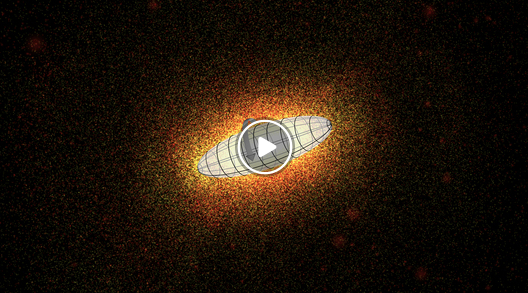
Movie 1
mp4_1920x1080 291,6MB
In-depth description: Astronomers discover unusual spindle-like galaxies
When most people think of galaxies, they think of majestic spiral galaxies like that of our home galaxy, the Milky Way: billions of stars, rotating in a flat disk similar to the way that a wheel rotates around its central axis. But while such disk galaxies are indeed common, accounting for roughly 70 % of all known galaxies in the nearby universe, some stellar systems are completely different. Notably, in so-called elliptical galaxies, stellar orbits are much more disorderly. Plot the stellar orbits in an elliptical galaxy, and the result will be similar to the external appearance of a ball of wool, with orbits oriented every which way.
Still, at least for most elliptical galaxies, this multitude of orbits follows an overall familiar trend: The vast majority of these galaxies are flattened in the direction of their rotation axis, as if pulled outward by centrifugal forces, resulting in a shape similar to that of a lentil. In these cases, there is at least some kinship with the wheel-like rotation of disk galaxies.
Spindle-like galaxies
But now, a group of astronomers led by Athanasia Tsatsi of the Max Planck Institute for Astronomy (MPIA) has found eight unusual galaxies whose overall shape resembles that of a cigar rotating along its longest axis; the technical term for such a shape is "prolate". Astronomers had known about "prolate rotators" like this for a while, but had considered them comparatively rare. The new observations, which were carried out in the context of the CALIFA survey of galaxies, almost double the number of known prolate rotators, from 12 to 20, in one go – demonstrating clearly that this kind of galaxy is much more common than previously thought – they seem to amount to almost 1/10 of elliptical galaxies. Surprisingly, when looking at the most massive of all elliptical galaxies, they found that a third of them showed prolate rotation!
Six of the prolate rotators that had been known before the present study had been studied more closely using a technique known as integral field spectroscopy (IFS). An IFS observation provides spectra of numerous different parts of the galaxy, which contain far more information than a galaxy's overall spectrum. The spectrum of a star – the rainbow-like decomposition of the star's light into numerous different colors, corresponding to different wavelength regions – contains well-defined dark lines, known as absorption lines; for some stars, there are also bright lines, called emission lines.
Spectra show motion patterns
When a star is moving towards us, its lines are shifted towards smaller wavelengths ("blueshift"), when it is moving away from us, towards longer wavelengths ("redshift"), in what is known as the Doppler effect. If the spectrum covers a whole region within a galaxy, corresponding to many thousands of stars, lines will appear both shifted (representing the overall motion of that region towards us or away from us) and broadened (representing stars moving towards us and away from us in the region that was observed). In this way, an integral field spectrum contains information about the patterns of motion within the galaxy. Typically, astronomers will try to extract that information by simulating a variety of cases of stellar motion in such a galaxy, and then comparing with the IFS data to see which pattern of motion fits the observational data best.
Rare spindles?
Out of the thousands of galaxies astronomers have studied in the last six decades, only about 12 elliptical galaxies with prolate rotation have been identified so far – and out of these 12 galaxies, only six have been studied with integral field spectroscopy. With such low statistics, no clear indication of how this type of galaxies may have come about, and until now they were considered extremely rare objects.
Enter the CALIFA survey, carried out at the Calar Alto Observatory in Spain from 2010 onwards. The survey uses the IFS instrument PMAS mounted at the Calar Alto Observatory's 3.5 metre telescope, which uses 350 optical fibres to guide light from a corresponding number of different regions of a galaxy image into a spectrograph. For the CALIFA survey, more than 900 galaxies in the local Universe, namely at distances between 70 and 400 million light years from the Milky Way, were selected from the northern sky to fully fit into the field-of-view of PMAS. They include all possible types, from roundish elliptical to majestic spiral galaxies, similar to our own Milky Way and the Andromeda galaxy. In total, more than 600 of these pre-selected galaxies were observed in depth, yielding a rich data set of galaxy details.
In that data set, Tsatsi and her colleagues found the eight new cigar-shaped prolate rotators, plus one further galaxy with some evidence for prolate rotation which the astronomers classified as a candidate, plus one galaxy whose prolate rotation had already been known and was now confirmed. The CALIFA observation plan meant that for all ten of these galaxies, they had high-quality IFS data, giving insight into stellar motion patterns of all these galaxies. With the new and old data combined, they could tackle the question of how these unusual rotation patterns could come about in the first place.
Merging galaxies
The general scenario for galaxies evolving into ever larger and ever more massive galaxies over time involves galaxy collisions and mergers. For instance, disk galaxies like our own Milky Way grow by repeatedly merging with much smaller galaxies, building up mass over billions of years. In fact, their spiral structure, which is a density pattern pulsating through the galactic disk, can be explained by the disturbances caused by such repeated encounters with smaller galaxies, as can the bars found in some galaxies: elongated structures in these galaxies' central regions, from which the spiral arms emerge.
When galaxy encounters involve two big and massive galaxies, the situation is different. In those cases, the typical result is an elliptical galaxy, with no clear remaining disk structure. If there is sufficient gas in the colliding galaxies, then as the galaxies spiral into each other, gas, and with it the stars, will be influenced by this galaxy-around-galaxy rotation ("conservation of angular momentum"), and the result will be a flat, rotating elliptical galaxy, of no interest to those hoping to explain the cigar-like prolate rotators.
Mergers without gas
Much more interesting is the case of galaxies that contain almost no amount of gas at all. In those "dry mergers", stellar orbits are decided on a more individual basis, depending on how stars are moving during the merger, not imposed by any bulk gas motion.
With the help of Jiang Chang, a former PhD student at the Max Planck Institute for Astronomy, and now at the Purple Mountain Observatory in China, the group simulated such dry mergers, looking for results that resembled the pattern of motion of their sample of prolate rotators. Their search was successful, and indeed yielded a candidate mechanism.
The mechanism in question involves what is called a polar merger: two disk galaxies, oriented at right angles, orbiting each other, their orbital plane aligned with the disk of one of the galaxies, and then merging. While the two disk galaxies can be very similar initially, the merger affects them rather differently: the galaxy whose disk is aligned with the orbital plane will develop a strong bar, while the galaxy whose disk is at right angles to the orbital plane will remain fairly undisturbed. As the galaxies merge, the bar-shape will become the cigar-like overall shape of the resulting galaxy, while the undisturbed disk sets the overall rotation along the long axis.
Comparison with the data indicated that the prolate rotators were very likely formed in this way about 10 billion years ago, when the universe was less than half its present age. The most striking example for prolate rotation resulted when the merging galaxies were almost pure disk galaxies, with no so-called "bulge" of older stars whose orbits carry them markedly below or above the plane of rotation.
The results are an interesting piece of the puzzle, explaining a likely formation scenario for an unusual, but not all that uncommon type of galaxy. Tsatsi's team of researchers having put to good use all the information contained in the CALIFA spectra, the ball is now in the court of the observing astronomers again: the merger simulations make some additional predictions for the detailed properties of prolate rotators, which cannot be distinguished with current observations, but could be tested with instruments like MUSE, the Multi Unit Spectral Explorer at ESO's Very Large Telescope, an 8-meter-telescope at Paranal Observatory in Chile.
